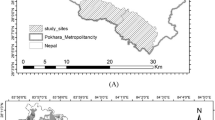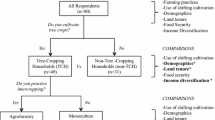Abstract
Most agroforestry-adoption studies are based on surveys of "non-adopters." An understanding of the circumstances that have led to a change of attitude of the adopters will be valuable in our efforts to enhance adoption rates. This study was undertaken to provide such knowledge based on a large agroforestry extension project involving 200,000 farm families and covering 25% of all rural households in Haiti. A questionnaire-based survey of the project participants was conducted covering 1,540 households and 2,295 fields in four regions of Haiti. Information was recorded about each farm and family member through interviews with farmers and visits to their farms. The results confirmed that farmers make decisions about tree culture based on household- and field characteristics. Different farmers consider trees differently depending upon how they fit into their farm-family strategy. In general, farmers installed tree hedgerows on fields of less secure tenure, of lesser fertility, and steeper slope, while on closer, more fertile fields of greater tenure security, tree seedlings and fruit trees were more common and there was a greater density of mature trees (>10 cm DBH). More money was realized from sale of tree products on actively cropped fields in more secure tenure and having more fertile soil. Older farmers managed a greater density of trees, especially when the land was in secure tenure status. This broad-based study shows that agroforestry implementation strategies in poor countries such as Haiti should be based on a thorough knowledge of how farmers use household and field characteristics to make adoption decisions. It also suggests that agroforestry-adoption studies should account for the dynamic changes occurring during extended time periods.
Similar content being viewed by others
References
Arnold M. and Dewees P. 1998. Rethinking Approaches to Tree Management by Farmers. Overseas Development Institute, London, ODI Natural Resource Perspectives No. 26.
Bayard B. 2000. Adoption and management of soil conservation practices in Haiti: the case of alley cropping and rock walls. MS thesis, Auburn University, Auburn, Alabama.
Biggelaar C. den 1994. Differentiating the nature of agroforestry systems and agroforestry knowledge among farmers in Southern Rwanda: participatory and formal approaches as complementary methods. Culture & Agriculture 50: 5–11.
Boyd C. and Slaymaker T. 2000. Re-examining the 'More people less erosion' hypothesis: special case or wider trend?, ODI Natural Resource Perspectives No. 63.
CIA The World Factbook-Haiti, accessed 13 September 2002., http:// www.cia.gov/cia/publications/factbook/geos/ha.html.
Current D., Lutz E. and Scherr S.J. 1995. The costs and benefits of agroforestry to farmers. World Bank Research Observer 10: 151–180.
Current D. and Scherr S.J. 1995. Farmer costs and benefits from agroforestry and farm forestry projects in Central America and the Caribbean: implications for policy. Agroforestry Systems 30: 87–103.
Ehrlich M., Conway F., Adrien N., LeBeau F., Lewis L., Lauwerysen H. et al. 1985. Haiti Country Environmental Profile: a field study. USAID, Port au Prince, Haiti, 120 pp.
Franzel S. and Scherr S.J. (eds) 2001. Trees on the Farm: Assessing the Adoption Potential of Agroforestry Practices in Africa. CABI, Oxford, UK.
Holdridge L.R. 1947. Determination of world plant formations from simple climatic data. Science 105: 367–368.
Jaffee D. 1997. Restoration where people matter: reversing forest degradation in Michoacán, Mexico. Restoration and Management Notes 15: 147–155.
Jickling J.L. and White T.A. 1995. Economic and institutional analysis of agroforestry projects in Haiti. In: Current D., Lutz E. and Scherr S. (eds), Costs, Benefits, and Farmer Adoption of Agroforestry. World Bank, Washington, DC.
Pattanayak S.K., Merecer D.E., Sills E.O., Yang J.-C. and Cassingham K. Taking stock of agroforestry adoption studies. Agroforestry Systems (in press).
Richards M. 1997. Tragedy of the commons for community-based forest management in Latin America? Overseas Development Institute, London, ODI Natural Resource Perspectives No. 22.
Scherr S.J. 1995. Economic factors in farmer adoption of agroforestry: patterns observed in western Kenya. World Development 23: 787–804.
Sieder P. 1994. Haiti - Traum und Wirklichkeit. Ein tragisches Beispiel aus der forstlichen Enwicklungshilfe. Forst und Holz 49: 40–46.
Smucker G.R., White T.A. and Bannister M.E. 2002. Land tenure and the adoption of agricultural technology in Haiti. In: Meinzen-Dick R., Knox A., Place F. and Swallow B. (eds), Innovation in Natural Resource Management: The Role of Property Rights and Collective Action in Developing Countries. Johns Hopkins University Press for the International Food Policy Research Institute, Baltimore, MD, pp. 119–146.
Smucker G.R. and Timyan J. 1995. Impact of tree planting in Haiti: 1982-1995. SECID/Auburn PLUS Report No. 23.
United Nations 2002. Global opportunity: Trends in sustainable development. The United Nations Department of Economic and Social Affairs, August 2002., http://www.johannesbursummit. org/html/documents/sumit&docs/criticaltrends&1408.pdf.
United Nations Development Programme 1996. Haiti 1994: Quelques indicateurs environnementaux de base., PNUD Haiti-Econet, Janvier 1996, Vol. 2, No. 1.
U.S. Department of State 2002. Background note: Haiti (13 September 2002). http://www.state.gov/r/pa/ei/bgn/1982.htm#econ
von Oppen A. 1993. Farmers, land and trees. Land conflicts and their ecological effects in Tanzanian villages after Ujamaa. Afrika Spectrum 28: 227–254.
Weil T.E., Black J.K., Blutstein H.I., Johnston K.T., McMorris D.S. and Munson F.P. 1973. Area Handbook for Haiti. U.S. Government Printing Office, Washington, DC, 189 pp.
White T.A. and Jickling J.L. 1995. Peasants, experts, and land use in Haiti: Lessons from indigenous and project technology. Journal of Soil and Water Conservation 50: 7–14.
Zuvekas C. 1979. Land tenure in Haiti and its policy implications: a survey of the literature. Social and Economic Studies 28: 1–30.
Author information
Authors and Affiliations
Corresponding author
Rights and permissions
About this article
Cite this article
Bannister, M., Nair, P. Agroforestry adoption in Haiti: the importance of household and farm characteristics. Agroforestry Systems 57, 149–157 (2003). https://doi.org/10.1023/A:1023973623247
Issue Date:
DOI: https://doi.org/10.1023/A:1023973623247




